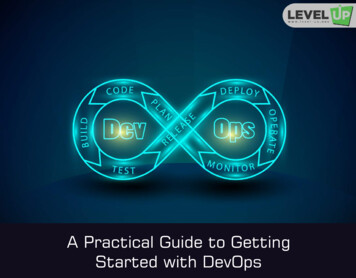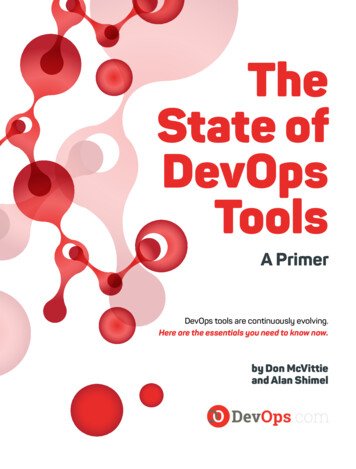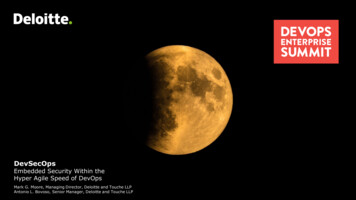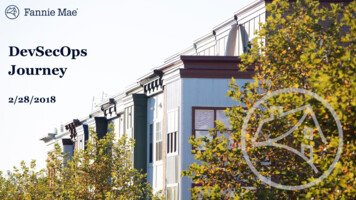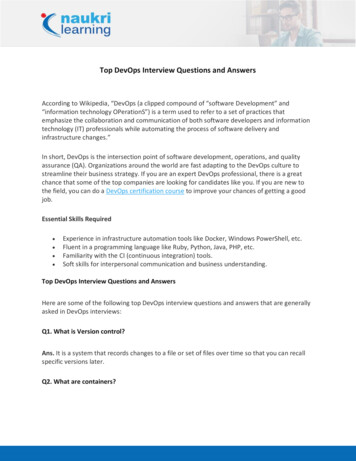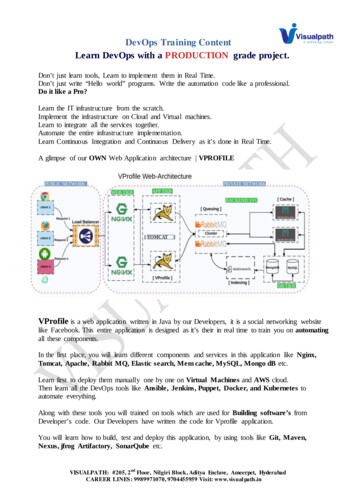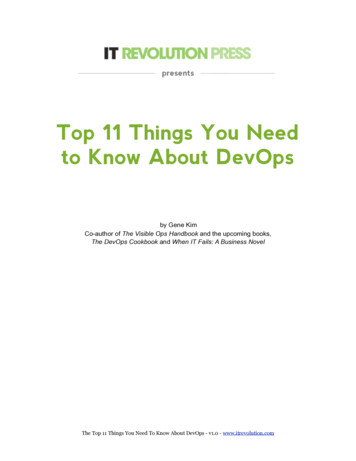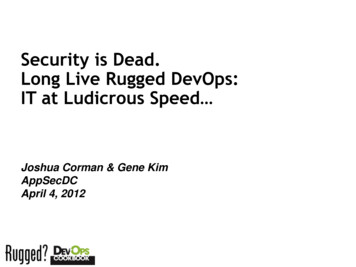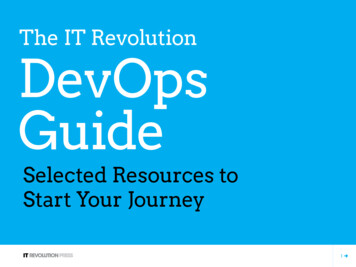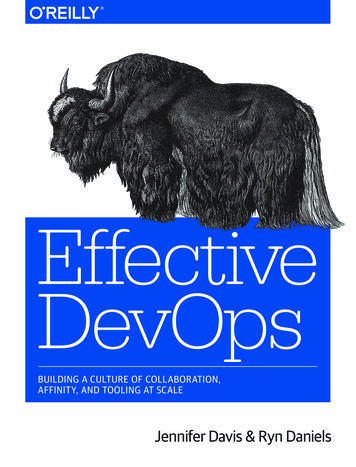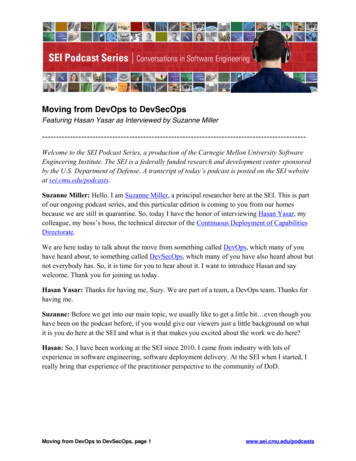
Transcription
Moving from DevOps to DevSecOpsFeaturing Hasan Yasar as Interviewed by Suzanne elcome to the SEI Podcast Series, a production of the Carnegie Mellon University SoftwareEngineering Institute. The SEI is a federally funded research and development center sponsoredby the U.S. Department of Defense. A transcript of today’s podcast is posted on the SEI websiteat sei.cmu.edu/podcasts.Suzanne Miller: Hello. I am Suzanne Miller, a principal researcher here at the SEI. This is partof our ongoing podcast series, and this particular edition is coming to you from our homesbecause we are still in quarantine. So, today I have the honor of interviewing Hasan Yasar, mycolleague, my boss’s boss, the technical director of the Continuous Deployment of CapabilitiesDirectorate.We are here today to talk about the move from something called DevOps, which many of youhave heard about, to something called DevSecOps, which many of you have also heard about butnot everybody has. So, it is time for you to hear about it. I want to introduce Hasan and saywelcome. Thank you for joining us today.Hasan Yasar: Thanks for having me, Suzy. We are part of a team, a DevOps team. Thanks forhaving me.Suzanne: Before we get into our main topic, we usually like to get a little bit even though youhave been on the podcast before, if you would give our viewers just a little background on whatit is you do here at the SEI and what is it that makes you excited about the work we do here?Hasan: So, I have been working at the SEI since 2010. I came from industry with lots ofexperience in software engineering, software deployment delivery. At the SEI when I started, Ireally bring that experience of the practitioner perspective to the community of DoD.Moving from DevOps to DevSecOps, page 1www.sei.cmu.edu/podcasts
SEI Podcast SeriesNow I have been leading a group, such a great group, including you and talking about the Agileand DevOps and DevSecOps and helping the DoD mainly but helping the other industries aswell. It is not just DoD but helping the community to improve their software delivery with fasterand better quality—not faster and fail, faster and better quality. Now we are calling it DevOps.Maybe in the future, we are going to call it something else, but our intent is always to deliversoftware faster, better, and high quality. I do like the work because the work is never going tostop. We have been demanding more of the software world. We have been seeing softwareeverywhere. Now, it is time to really look at what we can do to improve the level of the software,the high quality in the various applications. It is not just the web applications, it is everywhere atthis moment: mobile platforms, IoT [Internet of Things] devices, and everywhere. We are eventalking about the AI [artificial intelligence] component right now, but still, it is software at theend. So, I see it really is encouraging me and also motivating me. The work is going to stayforever, it seems to me, and I am really happy to see challenging environments and variousplatforms, various components with team cultures and technical stacks. So, I am really excited tocontinue the work.Suzanne: I will say, we have talked about this before, every time we solve a problem, there is anew one that comes up that is related somehow to software. So, yes, we are still busy. I havebeen in this at the SEI for decades, so it is amazing how even though we have solved a lot ofproblems, there is still a lot to work on. So, DevSecOps is actually I think a nice example of this.For those that do not know what DevOps and DevSecOps are, would you just summarize brieflywhat is DevOps, what is DevSecOps, and why do we even care that there is a difference?Hasan: Great question. So, I am going to start about how the DevOps started. So, you camefrom the Agile community, you know how Agile started. DevOps started in 2009 with the Agilemovement actually. It is not against it; it is a side effect of the Agile movement. So, why did thathappen? Actually, in 2009, a group of people from the operational team, they were really, notupset, but they would like to do something different in their operational environment to supportthe needs from Agile teams, which is dev teams that are making more incremental iterativechanges. For their applications they are building, their focus is more about customer work. Theirfocus is more about getting things done, not spending a lot of work on the paper or anything elsebut just spending more on the content of the work that needs to be delivered.So, the operational team, they said, Why don’t we change our mindset beyond Agile in operationworld, so we can receive the needs from the Agile team? That started in 2009 as a movementwith Patrick Debois and Clay Shafer. So, they got together and said, Let us change our mindset,make it the developer way to the Agile and operation environment. They came up with a term asDevOps term in the Twitter handle, and they started DevOps Days back in October 2009. So,Moving from DevOps to DevSecOps, page 2www.sei.cmu.edu/podcasts
SEI Podcast Seriesthat term actually stayed with the community as DevOps. It was DevOps Days initially. That’show it started.So, the initial intent was getting the developer and operational team working together, but peoplerealized that, the community realized that it is not enough. Having a more business-oriented,more supporting user needs, required other stakeholder involvement. That work had expandedmore including other stakeholders, not the dev and ops, other stakeholders [such as] acquisitionpeople, architects, and the security team, etc.So, then they built stakeholders, it was still oriented toward business needs and mission. Then itis more focusing on delivering the capabilities. Then we go really fast and fast and fast build, andsecurity people see another side effect of that DevOps movement. Such side effects are not ableto test enough for the security needs, not able to test enough for vulnerability analysis, not able toconnect the community with the security world. So, security got rather unintentionally forgottento be included into the DevOps process. You know, by definition of software attributes, wewould like to get security as part of architecture, but it did not work out with the DevOpscommunity.A couple of reasons I can say because when we start to use a more continuous integrationconcept or a continuous delivery concept, we are mainly using any type of continuation concept,which is very hyped right now. We are using an existing code multiple times in the existingenvironment like a platform or a backend. The developers start to use a lot of ready code. So,ready code has to be analyzed from the security teams. Developers will likely go or architectsthey will likely use existing frameworks or using existing libraries and technologies. That type ofmindset, again not intentional but unintentionally, opened up the vulnerabilities or mindset intothe DevOps pipeline such as, We are not able to address dependencies. Such as, We are not ableto address enough security testing, because we are going to go fast and fast. Because we focuson more customer needs and the customer never says, I need security. The customer says, I needthat feature. That is expected, but as an organization, that is our responsibility to Suzanne: They do not say they need security, but if you do not give them security then they arenot going to Hasan: Exactly. Nobody will be happy to see their data anywhere else. We see a lot of breacheshappening almost every day. Nobody is happy to see their information is being sold in a blackmarket. I am not happy, and you are not happy either. Nobody is going to be happy. We are notsaying that as a customer we need to protect our data, but that movement was not properlyaddressing that mission-specific security or specific compliance perspective. So, while we aredoing a lot of great work, and people like to see the great impact, we start to emphasize moresecurity into context of the DevSecOps.Moving from DevOps to DevSecOps, page 3www.sei.cmu.edu/podcasts
SEI Podcast SeriesSo DevSecOps started adding security into every phase of the lifecycle. It is not in one elementbut adding security into every phase of the lifecycle. That is how DevSecOps term started.Actually, I have another story on this one, and I have been participating in many DevOpsconferences, you know that. Then I have been also organizing and running a couple of eventswith the community together. So, as part of the big convention for the security convention, whichis RSA. The RSA Conference has been happening almost 20 years. So, we had a day for theDevOps Days we ran as part of the RSA Conference, but we were calling different DevOpsterms, like secure DevOps, rugged DevOps, we call it many definitions.About three years ago, as a community, we said, I know there’s a lot of people that are callingdifferent things, rugged DevOps, secure DevOps, DevOpsSec, SecDevOps, something. As acommunity, we asked the audience, we said, What are you going to call it? I know everybody iscalling different things. About 750 people joined our polling and everybody liked DevSecOps.Since that day, we are using the DevSecOps term as defining that concept of adding security intothe DevOps process. So, it is not in between dev and ops, but it is basically covering up alllifecycle. We can open up more. That is when the DevSecOps started actually.Suzanne: I like that as a term because it is really saying security is embedded inside dev andops, it is not outside of it. I suspect that is one of the reasons that it was popular. What are someof the challenges when you start making this shift, both in terms of organizationally From yourproduct viewpoint, what are some of the challenges of adopting a DevSecOps mindset,especially if you have already been doing DevOps, what are some of the things you are going tohave to think about changing?Hasan: Honestly, Suzy, based on the survey we have been running almost five years, if anorganization has DevOps as the maturity level—when I say the maturity, like, not reallyimplementing one component of DevOps. So, let us open up DevOps a little bit, so I can coverthe implementation details. So, when we say DevOps, we are looking for the full lifecycleperspective. If an organization has just an integration server, such as Jenkins, with repositorymanagement, with the tooling perspective, it is not DevOps. It is the one element of the coveringup continuous integration, maybe just not a continuous integration, just integration of the code.When we are adding a continuous term into that definition, we will likely see a continuity intothe lifecycle. How I set my requirements. What is my case I am working on? How many sprintsam I running? Which sprints am I in? Based on that continuity, we will likely see the continuousintegration process for any code changes. Then we will look to deliver the code we built that willgo to the staging or any test harnesses. When we are automatically deploying the production thatis what we will call continuous delivery.Moving from DevOps to DevSecOps, page 4www.sei.cmu.edu/podcasts
SEI Podcast SeriesSo, this is all connected with either a tooling perspective or the process perspective. The processis running an Agile process. Process, How we are going to do iterative and incrementaldevelopment? Technology pieces are, How we are going to architect our component that willsupport iterative and rapid development?So, all this continuity is really helping to eventually add security into it. Based on the survey, wefound out that if the organization has good maturity and the DevOps perspective and practiceswith the process and technology, they were able to add security into their DevOps process morethan 300 percent. It is interesting, not a couple of times, 330 percent they were able to get betteror faster adding security. Why is that? So, starting from the ground up, adding the security intheir components is not going to work out. If you have a good DevOps environment, it is veryeasy to add a security component into it.Why is that possible? Multiple reasons we can open up. One is we have a team structure that isalready available so we can add security, they use Scrum if they need to. We can add PIplanning. We can add sprint planning, post-mortem, etc., the process section of it. We have aplatform that the security people can share the information with the team members, easily [they]can share that. So, now we are covering up the technology pieces. Now that we have automationin place, which is the integration or the testing or automation perspective, that is what thesecurity people would like to see as artifacts. So, if an organization has DevOps, they were ableto easily add security into it and now we are calling it DevSecOps. We saw that as based on thestatistics.Suzanne: One of the things that in working with my customers I know that the security peoplehave appreciated, is that because we have this idea of a continuous pipeline, we are testing thecode many, many times as we make changes. That builds a body of evidence for the securitycommunity that vulnerabilities have not actually entered in. So, even though we are changing thecode, the fact that we are doing all this testing all the time gives them confidence that manyaspects of security testing, not all of them, but many aspects of security testing, they can kind ofcheck off and say, Yes, I have confidence. I have evidence. I have data to support that this aspectof security has been dealt with in the way that they built this code.The security people that I have talked to said that that opens them up to doing the more creative,interesting threats that they do not always have time to think about because they are really justdealing with a lot of the mechanics. That is one of the benefits that I have seen with mycustomers. What are some of the other things that you have seen in terms of the benefit tosecurity?Hasan: There are many benefits. Before going into the benefits, I forgot to add to the previousquestion. There are some roadblocks still, which is the trust problem. Think about the twoMoving from DevOps to DevSecOps, page 5www.sei.cmu.edu/podcasts
SEI Podcast Seriescommunities. Typically, I play the role of a developer, and I kind of play that role as security. Iwas thinking, I think we should do some play with how the interaction between developers andsecurity.Suzanne: Role play.Hasan: Right. I think we should role play sometimes. So, playing that role for myself—and Irealize that also teaching the software security class at CMU, I know how the security folks arethinking—there is a trust problem between two entities. Why? Because, first of all, securitypeople are assuming that the developer knows the concept of security. They know what thevulnerabilities are. They know what the best coding practices are. They are expected that theyshould know all the network stacks and IPs and etc. But in reality, the developer is not trainedwith security. They are not trained. They do not know. I mean, I have students Suzanne: Unless they take a class like yours.Hasan: Exactly. So, if they have time, probably yes. But in my class, and I have about 30, 35students each year, I ask that question all the time, like most of them are the CS [computerscience] department graduate and good universities all around the world, including CMU. Theydo not know the concept of security. I know they know at a high level, but they do not knowwhat needs to be done with respect to the technology, with respect to the tools. Also, they do notknow what is the specific networking and stuff because they train writing code or buildingsystems with architectures, or good database design, or good algorithm, or anything else.But security is a living thing, Susie. When I say living thing, it is not as the study guides learningsome language, it is a living thing because you have to really follow that up to speed, come upwith new technology, a new concept, a new idea. So, the hacker community or adversarycommunities are very up to date. It is really difficult for a developer following that, what ishappening as a trend, understanding all the vulnerabilities, all the possible thinking implementedin the code. So, that is kind of like, without knowing each other, now becoming developers areblaming the security folks as the gatekeeper and blocker. Security people are blaming the devteam for creating crappy code. It is basically, crappy code is bad code. It is creating evil thinkingbetween both parties. But both are intent on delivering good software. The developer’s intent isreally fixing a lot of functionalities, and the security people’s intent is to make resilient systems.So, they do not really converge, and how are we going to build that trust, as you said, in yourstatement, Susie, we can build up the component so the people can trust each other. So, are theygoing to trust each other? That’s what comes about in the picture because as the security people,if I know developers are working such component, which is libraries and code, then I can see afull transference like an application lifecycle including the artifacts, including the backend stuff,it makes me comfortable what developers are working on. So, I am not going to look at theMoving from DevOps to DevSecOps, page 6www.sei.cmu.edu/podcasts
SEI Podcast Seriesdeveloper in a suspicious way anymore because I can see how they are working, what they areworking, what type of tools they were using. Maybe I can give them an open kind ofenvironment, they can use the existing library that I have already verified as security people.Basically, transparency is building up trust between the two entities. The second thing is alsowith automation concept, automation testing, and analysis stuff, now the security people can seehow we are able to speed up the process by creating artifacts as security teams. Also, anotherthing that is important, the developer will use the existing operating systems or the boxes that thesecurity teams are advising, it will then give them enough comfort to say, Hey, I am a securityperson. I have already given them what operating system that they are going to use. Thedeveloper will use that, they are not going to use by themselves and pulling somewhere on theinternet, maybe going to Docker Hub, link something from Docker Hub, which is creating kindof trusted sources, and security people will use that. So, the biggest, biggest benefit for me, forboth entities, is creating a trust, which is important. Trust is based on transparency and visibility.So, they can see what is going on, they have full visibility of the pipeline, and which is creating alot of good input for security.Another important fact, and I am now going back to the other direction, so whenever the securitypeople were analyzing the code, they were able to send the feedback to the dev team in adigestible way. If there is no DevOps, which I worked in for years, when I send my code to thesecurity teams, they were analyzing the code, they were sending me 50 pages of the pen testingresults. Do you think that people have enough time to look at the 50 pages of the report,Suzanne?Suzanne: Eyes rolling in their heads.Hasan: Exactly. Because nobody has enough time. With the mindset of DevOps now, we areusing a lot of static analysis tools or dynamic analysis, whatever tools we are using, we are ableto create feedback on time and in a specific context. Another important factor, as I said this at thebeginning, Suzanne, we were expecting that everybody knows everything. It is a wrongassumption. Nobody knows everything. I mean, if everybody knows everything, I am happy tohire. We do not have those people. You should not be that either, because we are not going tocreate a person who knows everything, it is going to cause a problem eventually. But we wouldlike to increase our team knowledge. Team knowledge should be institutional knowledge in theorganization that we are building.So, with the feedback mechanisms, with the right tools, sending feedback through the chatwindow, it can be any type of mechanism they are using. The feedback has a couple ofcomponents, which is almost all that static analysis has: result of the analysis, what the problemis, what the solution is. So, technically we are teaching the developer what the solution is, so weMoving from DevOps to DevSecOps, page 7www.sei.cmu.edu/podcasts
SEI Podcast Seriesare building the knowledge. Now security teams instead of sending 50 pages of documents, nowthe system is sending their information in a way that the developer will know what the problemis, how to solve the problem, which is another great benefit which is continuous feedback we arecalling it. Now, we are expanding feedback equally into security, now the business, now the user,now the security teams are able to send feedback [in a timely way] to developers what needs tobe done.Suzanne: So, these are all things that the automation of the tool ecosystem, I mean, it is anecosystem now, it is not just a pipeline. But the automation inherent in the tooling ecosystem isone of the things that has really made a lot of what you are talking about possible. When I waswriting code in the ’80s, that was not feasible. I remember the very first automated testingsoftware that my company brought in for us to look at. Everybody would just laugh at it if theysaw it today, how cumbersome it was, and 50 pages of things to look at. It was not a useful wayfor us to learn about solutions to different kinds of problems.Many organizations struggle with this. What are the right tools? Do we help with criteria, arethere ways that we can help them to not say, Oh, you should use Jenkins or you should use this,but help them understand what are the choices that they need to make when they move in thisdirection? Are there criteria? You can say things like, your toolset is going to have, lowvulnerabilities. Okay. That is great. But if I am evaluating an offering for doing containerizationor something like that, how do I know? What kind of criteria do I use to say this is going to bemore secure than that? Do we have artifacts, resources that we can help people with in that area?Hasan: Exactly. So, let us open up that question a little bit further. So, I think, as we said at thebeginning, when we get a DevSecOps, we would like to have a software-delivery cycle shouldbe in place, which is DevOps we are calling it. But what are the principles of DevSecOps? Theprinciples are communication and collaboration, the principle of automation, infrastructure-ascode, and monitoring, which is sharing. So, all these concepts [are] the must-have things. If I ampicking tools, if a tool is not able to communicate with me in a proper way, which is I am tryingto address the communication principles of DevSecOps. So, how can we address the bettercommunication and collaboration of the tool I am using?Now, we are saying try some principles of DevSecOps. How can I do automation in theDevSecOps pipeline, or how can I add the monitoring concept into the pipeline? So, all theseprinciples we have to achieve in our DevSecOps pipeline. If I am going to pick the tools, wehave to say, What is the reason why I am going to pick these tools? In this integrated-pipelineconcept, what is the puzzle that is going to fit into my pipeline? When it is going to fit into mypipeline, can I integrate that into my pipeline, which is integrability? Can I get data from thosetools for a monitoring perspective? Can I use the infrastructure pieces like standing up the toolsMoving from DevOps to DevSecOps, page 8www.sei.cmu.edu/podcasts
SEI Podcast Seriesif I need to? Can I deploy independently? Can I maintain that tool independently, which isinteroperability?Suzanne: and can I swap it out?Hasan: Exactly. Right. How flexible is this? So, tools should give you that perspective. So, Ipick the reason that I am going to use. Let us say, I am going to pick a tool, the tool will do staticanalysis for me. Great. So, now I am going to ask a question myself, Can I add the staticanalysis tools into my pipeline? Is it going to fit with my build server? Maybe a Jenkins, maybeTeamCity, maybe Bamboo, it does not matter what it is. Can I integrate it into my pipeline? CanI integrate into my ID [integrated development] environment? I saw some tools are capable toreally give you feedback early in the lifecycle.The earliest feedback we can give in a lifecycle is when the developer is writing the code. Whenthe developer is writing code, they were using an IDE, integrated development environment. So,IDE is a good place to integrate the tools as an example. If I am able to, as a kind of tool owner,if I am able to give feedback to the developer when they are writing an object or a code, give thesyntax error, give some type of code practice when they write the code, this is the perfect way ofshifting left to see the concept all the way to the left side, which is [earlier] in the lifecycle. So,now I am looking for a tool perspective, so, Can I integrate here? Can I integrate there? Great. Iintegrated. Am I able to pull data from that tool so I can monitor quickly in my lifecycle? Nowyou are addressing a monitoring perspective. Now, can I share the outcome of the tools into thevarious collaboration portals like issue-tracking systems? Can a tool create an issue for meinstead of creating it manually?Now I am connecting the issue-tracking systems. See now we pick the tools, we put them inplace, we are asking the principles of DevOps, How can it increase the communication? Howcan it do automation? How can it do a monitoring perspective? If I am able to address all thesecommon principles, that is the biggest criteria. But what we started first was we start with, Whyare we going to use this tool? What is the purpose? It is very important. We do not want to go totools that we like. We do not want to go to tools that everybody is talking about in thecommunities.Suzanne: Everybody is using Cucumber.Hasan: But what is the reason?Suzanne: How they come up with these names, I have no idea.Hasan: Right. So, like exactly. Like we use the tools for our needs. I have an analogy that I havegiven many times before, I always describe when I teach the class, I say, when you go to HomeMoving from DevOps to DevSecOps, page 9www.sei.cmu.edu/podcasts
SEI Podcast SeriesDepot, you are looking for tools, which we do all the time when working our house on somelittle projects. We always look at the tools that meet our project needs. We are not paying a lot ofmoney. We have a project in our head. We all have put a list of it, we are just buying the toolswhat we need to for a specific project. It may not be exactly the same thing, but in software, it isthe same world. We have a project. We have to look at, Why I need to do that. What is thepurpose? What is the outcome?Suzanne: What you bring up there is actually really relevant because there are people—I havesome in my family—that go to Home Depot with a project in their head, and they get completelydistracted by all the tools that they did not know were available to do something like that. Insteadof coming home with a screwdriver, they come home with this automatic thing that dials around,dial in what you want, and the right screwdriver thing pops out. It is like, I just need a flatheadscrewdriver. What are we doing here? We see that in our tooling environments in DevOps andDevSecOps where all of a sudden people have said, Oh, we have to do that that that that thatthat, this whole list of things, and nobody is asking the question that is important: Why? So, yes,I definitely resonate with that, and I love the example because I resonate with that too.Hasan: Today, we are creating a lot of technical debt. Either keeping it in the garage, neverusing it at all, not effectively. In the software world, in the worst-case scenario, we can sell thetool, in a yard sale probably, but in the software world, it is done. We cannot sell anything. It isdone. You are part of it. Then the biggest, biggest challenge actually in the DevSecOps is thesustaining of the environments, Susie. We build up the tools, we build up the pipeline—who isgoing to maintain the pipeline? Who is going to update that? If we distracted ourselves a lot Suzanne: We never talk much about the fact that it is not just the technology environment thatchanges, but our threat environment changes. Ransomware did not exist 10 years ago. Nobodythought about the way that you hold somebody hostage or hold their data hostage to get moneyout of them. But now, that is a thing that we all have to deal with. I do not know what the nextthing is, and I am not sure I want to. But, there is always going to be something new in the threathorizon and threat environment that we also have to pay attention to. This is one of the reasonsthis is a never-ending problem set because there are always going to be people thinking of, Howdo I get around the blockade that you have put in front of your code? How do I get around that,so that I can do something that you do not want me to do?Hasan: Right. It is a good point, Susie, like what is next? When we say, What is next? we wouldlike to be resilient enough. We should be ready for any breaches down the road. So, how can webe ready for any type of disaster situation like a breach? Maybe ransomware is one of theexamples, maybe other breaches. In the software world, to be ready for any type of breach, wehave to know what we have of our assets, which would be our code. If something happens, weshould be able to respond quickly for any breaches. The response may be fixing code, theMoving from DevOps to DevSecOps, page 10www.sei.cmu.edu/podcasts
SEI Podcast Seriesresponse may be a patch of the soft
DevOps Days we ran as part of the RSA Conference, but we were calling different DevOps terms, like secure DevOps, rugged DevOps, we call it many definitions. About three years ago, as a community, we said, I know there’s a lot of people that are calling different things, rugged Dev

